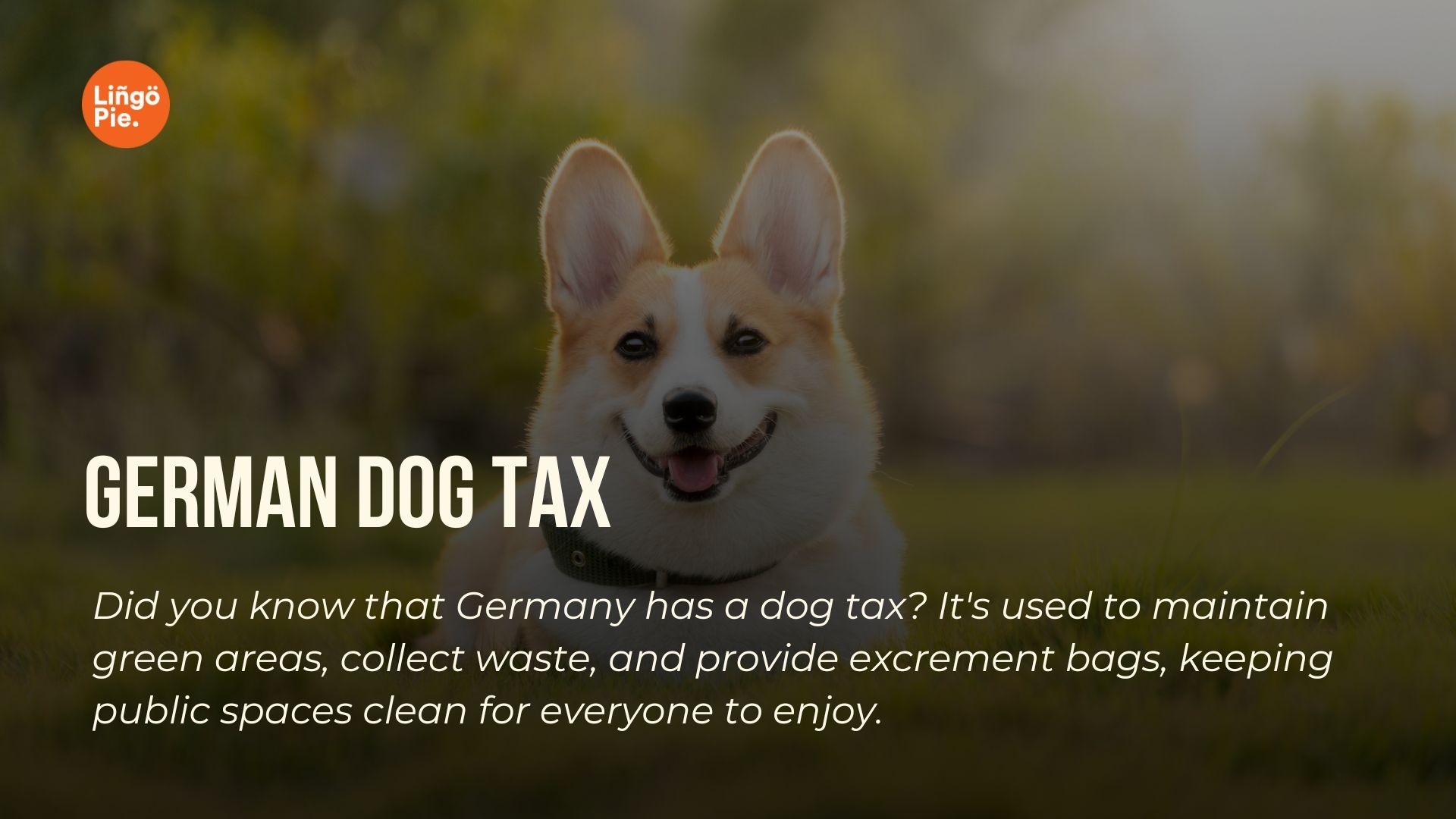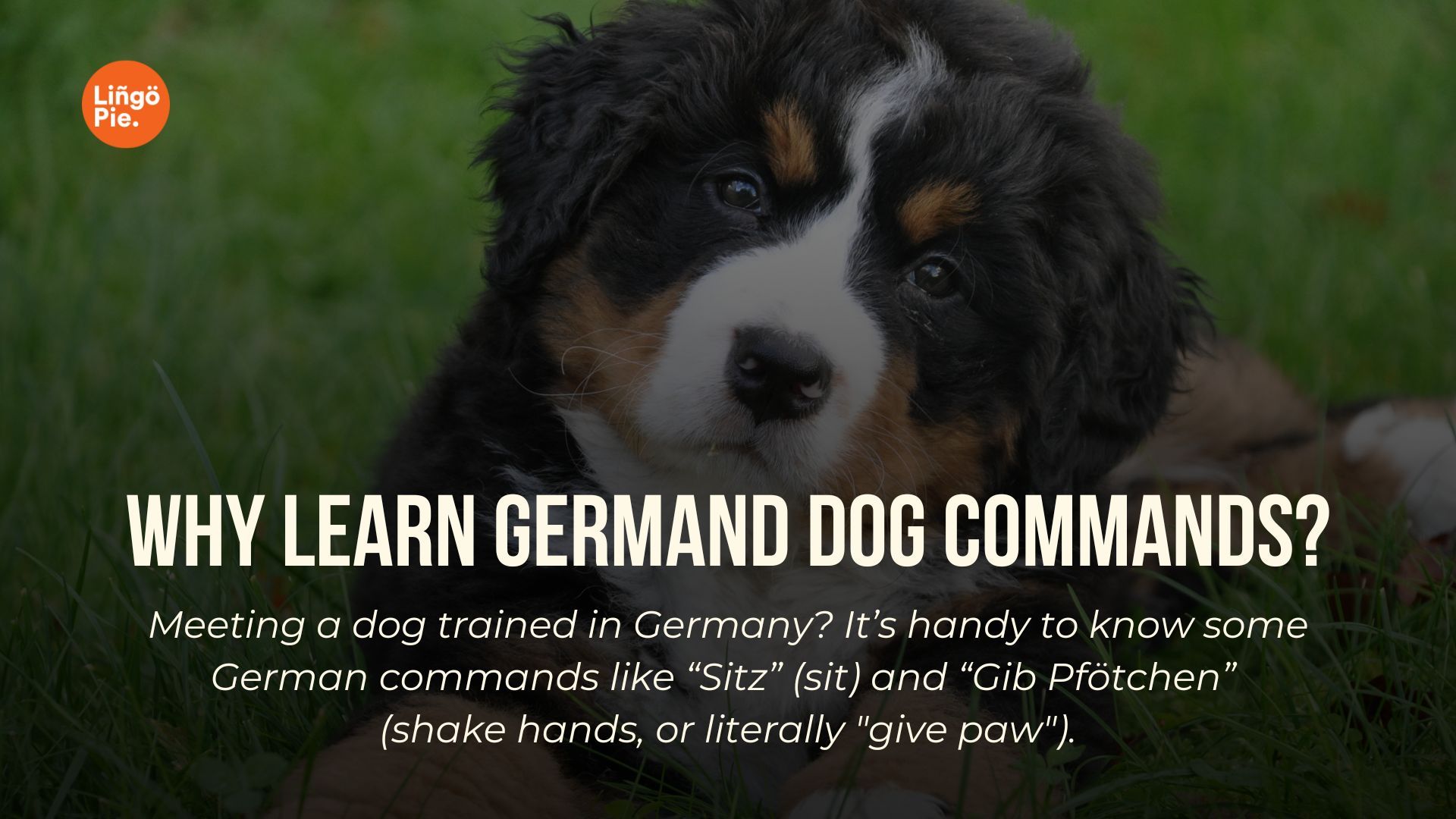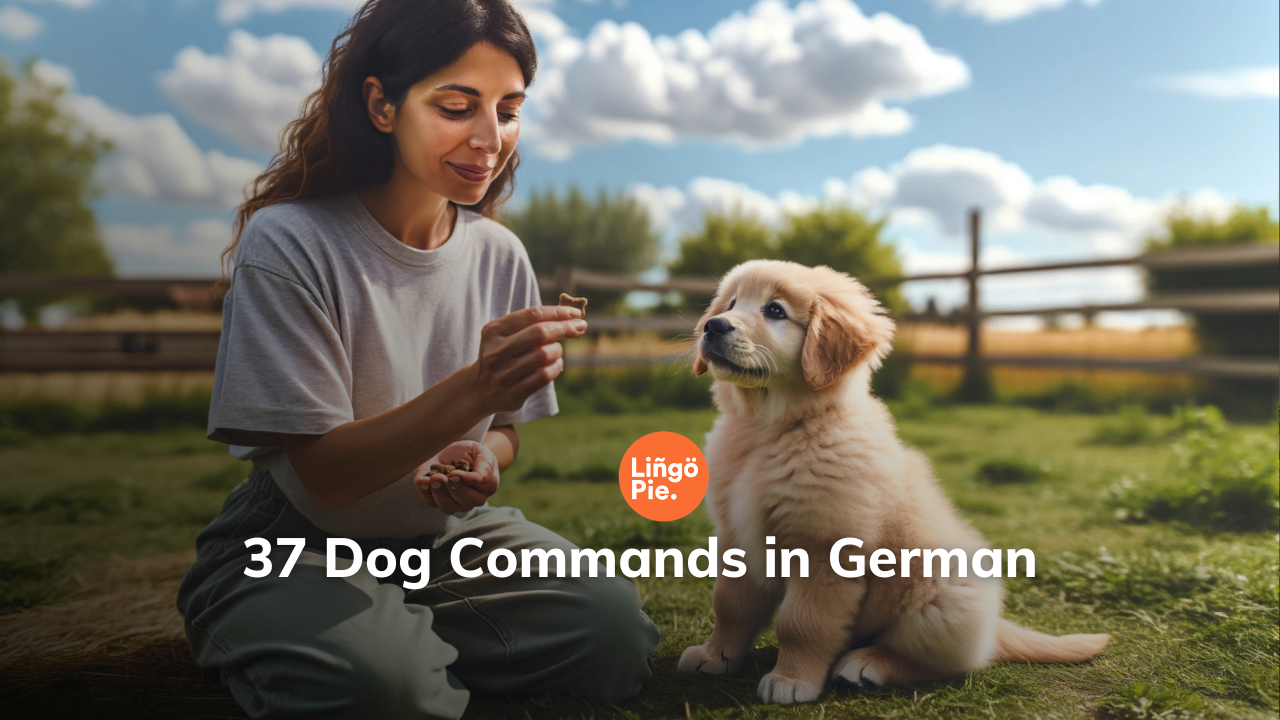As of 2024, over 60% of U.S. households own a pet. And since you landed in this post, there's a huge chance that you're trying to learn German to teach it to your pup.
For most people, mastering German dog commands is absolutely not essential. But hey, it's necessary if you want to connect with your new furry friends, especially when abroad in German-speaking countries. It can also be a fun topic when you're trying to learn German as a beginner.
So, in this guide, we'll explore 37 essential German dog commands, providing you with the foundational vocabulary needed to effectively communicate and train your canine companion.
Whether you're a native German speaker or simply seeking to enhance your dog's training in a foreign language, these command German words will serve as a valuable resource.
Get ready to strengthen the bond with your pet and navigate everyday situations confidently by incorporating these German language commands into your canine training routine.
Table of Contents
- Lingopie: Find Your Perfect German Command
- Best Dog Commands In German
- FAQ: German Dog Commands
- Types Of Dogs In German
- German Training Commands For Police Dogs
- Summing Up: German Commands For Dogs

Lingopie: Find Your Perfect German Dog Command
Before we get started, let us tell you about Lingopie.
Lingopie is an innovative language-learning platform that offers a unique approach to learning German through TV shows, movies, music videos, and podcasts.
With Lingopie, users can explore a vast library of entertaining and educational content for learners of all ages, making language acquisition a fun and immersive experience.
And for those looking to teach their furry friends German commands, Lingopie's features can serve as an invaluable tool. No, we don't specialize in German dog commands, but we do provide a diverse range of content that includes command words, phrases, and cultural insights.
Moreover, Lingopie makes for an excellent gift, allowing users to share the joy of language learning with friends or family.
Whether you're seeking English commands translated into German or exploring words in different languages, Lingopie offers a comprehensive and engaging learning environment.
Read Also:



Best Dog Commands In German
Right, let's get into it. Read on to find a comprehensive list of 37 essential German dog commands.
From basic obedience to fun tricks, mastering these commands will not only enhance your communication with your furry friend but also add a touch of linguistic flair to your daily interactions.
- Sitz [zɪts]: Sit
Directs the dog to lower its hindquarters onto the ground, maintaining a seated position until given further instruction. - Bleib [blaɪ̯p]: Stay
Commands the dog to remain in its current location and position until given another command. - Bravo [ˈbʁaːvoː]: Good job
Employed to praise your pup, usually to reinforce positive behavior after they've correctly followed another command. - Braver Hund [ˈbʁaːfɐ ˈhʊnt]: Good dog
Praise your pup, sparking those happy tail wiggles. - Gib Pfote [ɡɪp ˈpfɔːtə]: Shake hands
Signal your dog to lift a paw for a friendly handshake. - Aus [aʊ̯s]: Drop, Drop it
Command your dog to release whatever is in its mouth. - Bei Fuß [baɪ̯ ˈfuːs]: Heel
Instruct your dog to walk beside you, not ahead or behind. - Komm [kɔm]: Come
Call your dog to return to you. - Hier [hiːɐ]: Here
Similar to "come," beckoning your dog to follow. - Los [loːs]: Go
Give your dog permission to move or run. - Platz [plats]: Down
Direct your dog to lie down. - Steh [ʃteː]: Stand
Ask your dog to stand up. - Rolle [ʁɔlə]: Roll over
Tell your dog to lie down, roll over, and stand up. - Hol [hoːl]: Fetch
Instruct your dog to retrieve a thrown object. - Hol Stöckchen [hoːl ˈʃtœkçən]: Fetch the stick
Specific command for your dog to fetch a thrown stick. - Gib Laut [ɡɪp laʊ̯t]: Speak
Tell your dog to make noise, usually one bark. - Hopp [hɔp]: Jump
Instruct your dog to leap over an obstacle or jump into the air. - Lauf [laʊ̯f]: Run
Encourage your dog to stretch their paws and run free. - Nein [naɪ̯n]: No
General command used to prevent any unwanted behavior. - Halt [halt]: Stop
Command your dog to halt any ongoing action. - Langsam [ˈlaŋzam]: Slow
Instruct your dog to reduce speed. - Schneller [ˈʃnɛlɐ]: Faster
Encourage your dog to increase speed. - Geradeaus [ɡəˈʁaːtəˌʔaʊ̯s]: Straight ahead
Direct your dog to continue moving forward. - Rechts [ʁɛçts]: Right
Direct your dog to go right. - Links [lɪŋks]: Left
Direct your dog to go left. - Warte [ˈvaʁtə]: Wait
Let your dog know you want them to wait for you. - Vorwärts [ˈfoːɐ̯vɛʁts]: Onwards
Encourage your dog to keep moving forward. - Gib Küsschen [ɡɪp ˈkʏsçən]: Give a little kiss
Encourage your dog to “kiss” your hand or even let them lick your face if your love goes that deep. - Tanz [tants]: Dance
A cute way to ask your dog to stand on their hind legs. - Dreh dich [dʁeː dɪç]: Twirl
Ask your dog to turn around, also a great dance move! - Schwimm [ʃvɪm]: Swim
Give this command when you're taking your dog to the beach or a lake. - Kriech [kʁiːç]: Crawl
Use this command if you want your dog to crawl underneath a fence or another obstacle. - Fass [fas]: AttackGiven to a police dog to apprehend a suspect, typically by biting and holding on. Reserved for situations where the suspect is seen as a significant threat.
- Bring [bʁɪŋk]: Retrieve
Commands the police dog to pick up an item with their mouth and bring it back to the handler, such as evidence or items of interest during a search. - Such; Revier [zʊχ; [ʁeˈviːɐ̯]: Search
Instructs a police dog to look for something specific like a missing person, drugs, explosives, or evidence at a crime scene. The dog is trained to signal its handler when hearing police dog commands, by barking, lying down, and pointing with its nose when it has located the target. - Platz; Zurück [plats; tsuːˈʁʏk]: Back
Instructs the police dog to walk backward, typically for crowd control purposes. - Ruhig; Aus [ˈʁuːɪ̯ç; ʔaʊ̯s]: Quiet
Tells the police dog to stop barking, especially important during covert operations.

Types of Dogs in German Language
Understanding different types of dogs in the German language can be helpful, especially for those looking to adopt or learn more about specific breeds in German-speaking countries.
| English | German |
|---|---|
| Dog | Hund |
| Puppy | Welpe |
| German Shepherd | Deutscher Schäferhund |
| Dachshund | Dackel |
| Poodle | Pudel |
| Boxer | Boxer |
| Bulldog | Bulldogge |
| Beagle | Beagle |
| Rottweiler | Rottweiler |
| Golden Retriever | Golden Retriever |
| Great Dane | Deutsche Dogge |
| Cocker Spaniel | Cocker Spaniel |
| Chihuahua | Chihuahua |
| Siberian Husky | Sibirischer Husky |
| Labrador Retriever | Labrador Retriever |
| Bernese Mountain Dog | Berner Sennenhund |
| Maltese | Malteser |
| Shih Tzu | Shih Tzu |
| Saint Bernard | Bernhardiner |
| Dalmatian | Dalmatiner |

German Training Commands For Police Dogs
Using German commands in police dog training has practical advantages. Since German is not commonly spoken, it prevents outsiders from easily controlling the dogs. This helps ensure that police dogs, or K9s, respond only to their handlers, even in high-pressure situations.
Here are some specific training commands for police dogs:
| English | German | Purpose |
|---|---|---|
| Alert | Anzeigen | Commands the dog to signal when they have found something |
| Attack | Fass | A command given to apprehend a suspect, typically by biting and holding on, reserved for significant threats |
| Back | Platz; Zurück | Instructs the dog to walk backwards, typically for crowd control purposes |
| Guard | Wach; Pass auf | Commands the dog to protect a specific area or person |
| Quiet | Ruhig; Aus | Tells the dog to stop barking, which is especially important during covert operations |
| Retrieve | Bring | Commands the dog to pick up an item with their mouth and bring it back to the handler, such as evidence or items of interest during a search |
| Search | Such; Revier (for area search) | Instructs the dog to look for something specific like a missing person, drugs, explosives, or evidence at a crime scene. The dog signals its handler when it locates the target. |
| Track | Fährte; Spur | Signals the dog to follow a scent trail |
These commands ensure that police dogs can perform their duties effectively and securely, enhancing their role in law enforcement.

Common Misconception: Dogs And Language
Common misconceptions about dogs and language often stem from the belief that dogs don't truly understand verbal commands, regardless of the language used.
However, the reality is more nuanced, especially when considering different types of training, such as that of police dogs versus regular pets.
While it's true that dogs don't comprehend language as humans do, they respond to commands based on the memory of the tone and voice associated with those commands. This recognition is crucial for effective training, and it underscores the importance of using the right language.
Whether it's English, German, or another language, dogs respond more positively to commands given in the language they were trained in.
For instance, most police dogs in Germany are often trained with same dog German commands, and using these dog training commands ensures consistent and accurate responses. The tone, pitch, and rhythm of the spoken words become familiar cues for the dog, helping them associate specific actions with the spoken language.
FAQs Relating to German Dog Commands
Let's take a look at some frequently asked questions about dog training commands in German.
What does Platz mean for dogs?
Platz is a German command for dogs, translating to "down" or "lie down" in English. It is a common cue in dog training, instructing the dog to lower its body and remain in a lying position until given further direction.
What does foose mean in German?
"Foose" seems to be a misspelling. If referring to "Fuß," it means "heel" in English, instructing the dog to walk closely beside the handler.
What are the German words for dog?
The German word for dog is "Hund" for a singular dog, and "Hunde" for multiple dogs. Using these terms is essential for effective communication with dogs, especially in training scenarios where clear and consistent commands contribute to a better understanding between the handler and the canine.
What does Fass mean in dog training?
Fass is a German dog command in dog training, often used for police dogs. It means "attack," instructing the dog to apprehend a suspect, typically by biting and holding on.
Summing Up: German Commands For Dogs
While it's not something most people need to know on a daily basis, mastering German dog commands is vital if you have a dog yourself, or one in training. Knowing these commands ensures your furry friend understands and responds appropriately.
From basic commands like "Sitz" (sit) to specialized instructions, each word holds significance.
There's no doubt that learning these commands enhances your bond with your pet.
So, get ready to dive into the wealth of commands available and learn German commands now for a well-trained and happy pup.
Still with us? Great - why not sign up to a free trial with Lingopie and start learning German today?










